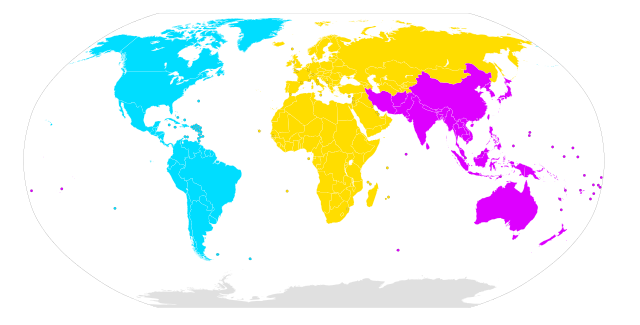Top Qs
Timeline
Chat
Perspective
9-centimeter band
Amateur radio frequency band From Wikipedia, the free encyclopedia
Remove ads
The 9-centimeter band is a portion of the SHF (microwave) radio spectrum internationally allocated to amateur radio and amateur satellite use. The amateur radio band, in ITU regions 1 and 2, is between 3.300 GHz and 3.500 GHz, and it is available only on a secondary basis. The amateur satellite band is between 3.400 GHz and 3.410 GHz, and it is only available in ITU Regions 1 and 2, on a non-interference basis to other users (ITU footnote 5.282). In Germany and Israel, the band 3.400 - 3.475 GHz is also allocated to the amateur service on a secondary basis (ITU footnote 5.431).[1]
In CEPT's "European Common Allocation Table", footnote EU17 allocates 3.40 GHz to 3.41 GHz to European amateurs on a secondary basis.[2][3]
In the US, the FCC is recommending removing the amateur service from this band in order to make room for the 5G cellular system. There have been many objections to this proposal by Amateur Radio operators, including the ARRL.[4]
Remove ads
History
This section needs expansion with:
|
List of notable frequencies

Region 1
Region 2
Region 3
- 3.4001 GHz: IARU Region-1 calling frequency[3] and Global EME center of activity[3][5]
- 3.4561 GHz: IARU Region 2 calling frequency[5]
Radio Astronomy
3.332 - 3.339 GHz and 3.3458 - 3.3525 GHz are used by radio astronomers for spectral line observations.[5] Amateur stations voluntarily avoid using these frequencies when in geographic proximity to a radio telescope. ITU footnote 5.149 encourages all radio communications in the band to take practical steps to avoid harmful interference to radio astronomy observations in those frequency ranges.[1]
Remove ads
Countries with more restricted allocation
Australia
The ACMA allocates 3.300 to 3.400 GHz for Amateur Radio use for Advanced certificate holders, with a maximum power of 120W Px, or 400W Py. (Operation from 3.400 to 3.600 GHz is only allowed in remote areas of Australia). See Table C in the Radiocommunications (Amateur Stations) Class Licence 2023.[6]
Sweden
The Swedish Post and Telecom Authority (PTS) does not consider 3.4 GHz to be an amateur band, and has therefore auctioned it off for 5G test use. Temporary permits in the 3.400 - 3.401 GHz range are currently issued however.[7]
Spain
The Ministerio de Asuntos Económicos y Transformación Digital does not allow 3.4 GHz to be used by amateurs. Currently this band is used by 5G services.
See also
References
Wikiwand - on
Seamless Wikipedia browsing. On steroids.
Remove ads